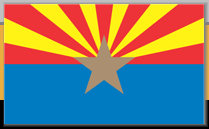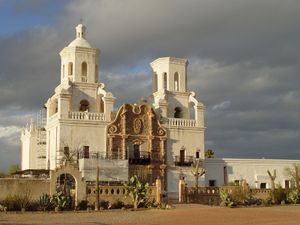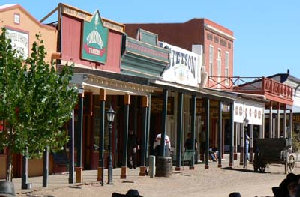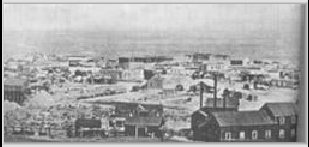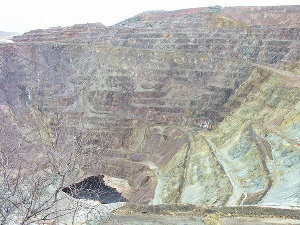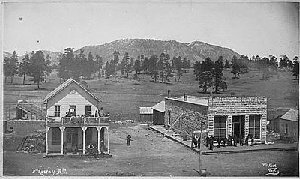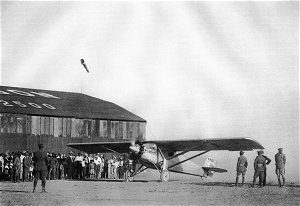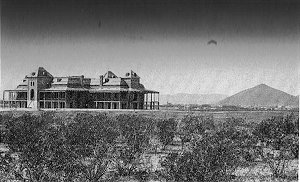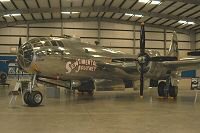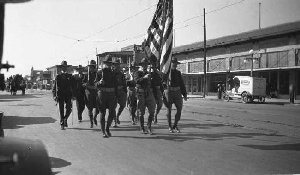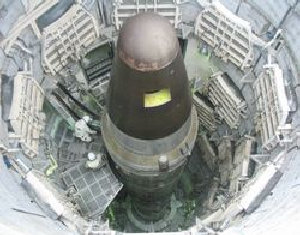Arizona Statehood
In the 1900s, Arizona almost entered the Union as part of New Mexico in a Republican plan to keep control of the U.S. Senate. The
plan, while accepted by most in New Mexico, was rejected by the vast majority of those living in Arizona. On February 14, 1912, Arizona
finally
entered the Union as the 48th state of the United States. The
Arizona constitution created a
storm, with such “radical”
political features as initiative, referendum, and judicial recall. Only after recall had been deleted did President Taft sign the
statehood bill. Once admitted to the Union, Arizona restored the recall provision.
Arizona Universities
The precursor to the
University of Arizona, the Arizona Territorial University was opened in 1891 on land donated by a saloon keeper
and a pair of gamblers, and $25,000 provided by the territorial government. The local politicians were disappointed at the appropriation,
instead hoping for money to build the territory's mental hospital.
Classes met for the first time in 1891 with 32 students in Old
Main, the first building constructed on campus, and still in use to this day.
Arizona State University was established in Tempe in
1885 by an act of the Thirteenth Territorial Legislature, ASU was initially formed as a teachers college. The core of the Tempe campus
was a twenty-acre cow pasture donated by leading citizens who sought an institution to train public school teachers, and provide instruction
to their sons and daughters in agriculture and the mechanical arts.
Northern Arizona University began as the
Northern Arizona
Normal School, which was formed on September 11, 1899. In 1925, the State of Arizona recognized the school, allowing it to grant the
Bachelor of Education degree. Following this change, the school renamed itself Northern Arizona State Teacher's College. In 1929,
the name was changed to Arizona State Teacher's College at Flagstaff.
In 1945, its name changed once again to the Arizona State College
at Flagstaff. A year later the college began offering the degrees of Master of Arts and Bachelor of Science. On May 1, 1966, the school
was granted full university status and changed its name to the current Northern Arizona University (or NAU).
The 20th Century
By the time it became the
48th state in 1912, Arizona was famous for the sunny climate and dry air that made it ideal as a healthful
spot where people could visit and settle. Tucson became a destination for tuberculosis patients from all over the world.
After
achieving statehood, Arizona transformed from a frontier territory into a modern, sophisticated state. World War I (1914–18)
spurred the expansion of the copper industry, intensive agriculture, and livestock production.
In 1920 Tucson became the
first city in the nation to have a municipal airport (at the location of the present-day Davis-Monthan AFB). Charles
Lindbergh visited
the Tucson Airfield once. He was on a tour of the United States that started at Mitchel Field, Long Island, New York, July 20, 1927,
and ended at Mitchel Field on October 23, 1927. His tour was a celebration of his recent transatlantic success. Lindbergh landed in
Tucson on the afternoon of September 23rd flying the "Spirit of St. Louis". After landing, he spoke to a crowd of about 5,000 people
on the University of Arizona campus. On the following day, October 24, 1927, at 7:50 a.m. Lindbergh took to the skies to continue
his somewhat grueling victory tour.
In 1985 the state acted to bring water from the Colorado River to its own citizens by building
the
Central Arizona Project (CAP). The CAP was a $3 billion network of canals, tunnels, dams and pumping stations which had the capacity
to bring 2.8 million acre-feet of water a year from the Colorado River to Arizona's desert lands, cities, and farms.
Today Arizona
is a leader in manufacturing, aerospace, electronics, and agriculture, as well as a major draw for tourists and retirees from all
over the world. The
top manufacturing sectors for Arizona, in rank order, are: computers and electronics, transportation
equipment, fabricated metals, food products, nonmetallic minerals, and machinery.







This website was created and is maintained by:
Philip J. June
Tucson, AZ
This website was first created
and published on 11.27.07;
Last update was 11.27.07
Tombstone Street
Tombstone - 1891
Open Pit Copper Mine - Bisbee
Flagstaff Post Office - 1899
Lindbergh and "Spirit of St. Louis"
in Tucson - 1927
Unfinished Old Main at UA - 1890
Mission San Xavier del Bac
Arizona
The
Grand Canyon State
History of
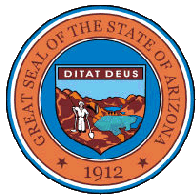
In 1867,
Jack Swilling of Wickenburg stopped to rest his horse at the foot of the north slopes of the White Tank Mountains. He looked
down and across the expansive Salt River Valley and his eyes caught the rich gleam of the brown, dry soil turned up by the horse's
hooves. He saw farm land, predominately free of rocks, and in a place beyond the reach of heavy frost or snow. All it needed was water.
Returning
to Wickenburg, he organized the Swilling Irrigation Canal Company, and moved into the Valley. The same year, the company began digging
a canal to divert some of the water of the Salt River onto the lands of the Valley. By March 1868, water flowed through the canal,
and a few members of the company raised meager crops that summer.
By 1868, a small colony had formed approximately four miles east
of present day Phoenix. Swilling's Mill became the new name of the area. It was then changed to Helling Mill, after which it became
Mill City, and years later, East Phoenix.
Phoenix was officially was recognized on May 4, 1868. In 1889 Phoenix became the capital
city of Arizona, moving from Prescott.
Phoenix
Bisbee
In 1880, the residents of the mining area southeast of Tucson named their community
Bisbee, after Judge DeWitt Bisbee, a financial
backer of the
Copper Queen Mine. Once known as “the Queen of the Copper Camps”, this Old West mining camp proved to be one of
the richest mineral sites in the world, producing nearly three million ounces of gold and more than eight billion pounds of copper,
not to mention the silver, lead and zinc that came from these rich Mule Mountains. By the early 1900s, the Bisbee community was the
largest city between St. Louis and San Francisco.
Flagstaff
European American settlers did not move into the
Flagstaff area until the 1870s, soon after the Apaches had been driven to southeastern
Arizona. A few colonizers arrived in 1876 and established a settlement called Agassiz near San Francisco Peaks but, lacking the knowledge
and technology of the Sinagua, decided that the area was not good for farming. A sheepherder named Thomas Forsythe MacMillan eventually
arrived in the area and concluded that it was a great land for raising sheep. By 1880, the area's population had grown to 67.
Two years later, the Atlantic and Pacific Railroad (now the Santa Fe) arrived, and the town's future was secured.
In 1912, Flagstaff
just barely missed the opportunity to become the movie capital of the world, when director Cecil B. DeMille came looking for a location
where outdoor shooting was possible all year round. Unfortunately, a snow flurry descending on the town convinced him that this was
not the place, and he moved further west to a region with more agreeable weather, to someplace called Hollywoodland.
Tombstone
Like many cities in Arizona,
Tombstone was originally settled by miners working the silver and gold mines. In 1877 silver was
discovered at Tombstone, setting off a boom that drew throngs of prospectors to the area but lasted less than 10 years.
Tombstone is best know for it's wild west days with Marshall
Wyatt Earp blurring the lines between lawman and criminal, and of
course the less than 60 second gunfight at the OK corral. The
gunfight that happened at 3 p.m. on Wednesday, October 26, 1881,
in a vacant lot, known as lot 2, in block 17, behind the corral in Tombstone, Arizona Territory is more legend than truth, but it
is a well-know legend.
Brigham Young sent Mormons to Arizona in the mid-to-late 19th century. They founded Mesa, Snowflake, Heber, Safford and other towns.
They also settled in the Phoenix Valley (or "Valley of the Sun"), Tempe, Prescott, among other areas. The Mormons settled what became
known as Northern Arizona and northern New Mexico, but these areas were located in a part of the former New Mexico Territory.
In 1883, workers completed the Atchison, Topeka and Santa Fe Railway across northern Arizona, thereby linking St. Louis, Mo., with California; that same year the Southern Pacific Railroad completed a line from New Orleans to Los Angeles by way of Tucson and Yuma.
B17 on Display at Pima Air and Space Museum
Tucson
Phoenix Parade - 1917
Titan Missile Museum - Green Valley
Wikipedia






